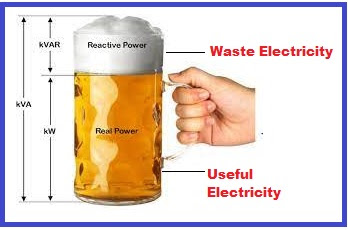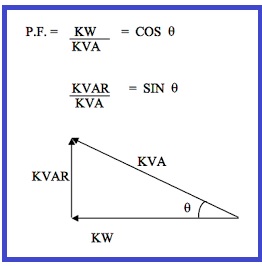KVA Full Form in Electrical | What is KVA | What is KVA Power | What is KVA Rating | What is KVA and KW | What is KVA Rating of Transformer | MVA Full Form in Electrical | KVA Calculator | KW Calculator
KVA Full Form in Electrical is kilovolt-ampere and is a unit of power in electrical systems. It is often used to describe the capacity of electrical equipment such as transformers, generators, and motors. KVA represents the total amount of power that an electrical system can handle, regardless of its efficiency or power factor.
KVA Full Form in Electrical | What is KVA | What is KVA Power
- KVA stands for kilovolt-ampere, which is a unit used to measure apparent power in an electrical circuit. 1 KVA= 1000 VA (volt-amperes)
- It is different from kilowatt (kW), which measures real power, and takes into account the phase difference between the voltage and current in the circuit.
- KVA is used to determine the maximum capacity of electrical equipment, such as transformers, generators, and UPS systems.
- It is important to correctly size electrical equipment based on the KVA rating to ensure that it can handle the required load without overheating or tripping.
KVA Calculator | KW Calculator
Enter the following values to calculate KVA and KW:
In simple terms, KVA is the measure of the maximum amount of electrical power that an electrical system can handle without overloading. It is a critical parameter in designing and selecting electrical equipment, as it determines the size and capacity required to meet the power demands of a particular application.
One of the most common uses of KVA is in specifying the size and capacity of transformers. Transformers are used to convert electrical energy from one voltage level to another, and the KVA rating of a transformer determines its capacity to handle power. For example, a 500 KVA transformer can handle a maximum power load of 500 kilovolt-amperes.
In addition to transformers, KVA is also used to specify the capacity of generators and motors. For generators, the KVA rating determines the maximum amount of power that can be generated, while for motors, the KVA rating determines the maximum amount of power that can be supplied to the motor.
It is important to note that KVA is not the same as kilowatts (KW), which is a measure of actual power delivered to a load. KVA includes both real power (measured in KW) and reactive power (measured in KVAR), which is the power required to create and maintain magnetic fields in electrical equipment.
MVA Full Form in Electrical | What is MVA in Electrical?
MVA stands for Mega Volt-Ampere, which is a unit of electrical power. It is a measure of the total amount of power that can be transmitted or supplied by an electrical system.
In electrical engineering, MVA is used to express the power rating of large electrical equipment such as transformers, generators, and transmission lines. These equipment are designed to handle large amounts of electrical power, which are typically measured in MVA.
MVA is calculated by multiplying the voltage and current values in a three-phase power system. For example, if the voltage and current values in a three-phase system are 11 kV and 1000 A respectively, then the apparent power (in VA) would be 11,000,000 VA or 11 MVA.
MVA is an important parameter in the design and operation of electrical systems. It is used to determine the capacity of the equipment and the transmission lines required to handle the power demand of the system. It is also used to determine the stability and reliability of the system under normal and abnormal operating conditions.
1 MVA = 1000 KVA
KVA Formula
Both real power (measured in kW) and reactive power (measured in kVAR). The formula for calculating KVA is:
KVA = (Volts x Amps) / 1000
Where:
Volts = the voltage of the electrical system
Amps = the current flowing through the system
To use this formula, you need to know the voltage and current of the electrical system in question. Once you have these values, simply multiply the voltage by the current, and divide the result by 1000 to get the KVA.
KVA Example
For example, let's say you have a system with a voltage of 480 volts and a current of 100 amps. Using the formula above, you can calculate the KVA as follows:
KVA = (480 x 100) / 1000
KVA = 48
So the KVA of the system is 48 KVA.
What is KVA and KW
The formulas for calculating KW and KVA are:
KW = Volts x Amps x Power Factor / 1000
Where:
Volts = the voltage of the electrical system
Amps = the current flowing through the system
Power Factor = the ratio of real power (KW) to apparent power (KVA)
KVA = (Volts x Amps) / 1000
Where:
Volts = the voltage of the electrical system
Amps = the current flowing through the system
To use the KW formula, you need to know the voltage, current, and power factor of the electrical system in question. Once you have these values, simply multiply the voltage, current, and power factor, and divide the result by 1000 to get the KW.
For example, let's say you have a system with a voltage of 480 volts, a current of 100 amps, and a power factor of 0.8. Using the KW formula above, you can calculate the KW as follows:
KW = 480 x 100 x 0.8 / 1000
KW = 38.4
So the KW of the system is 38.4 KW.
To use the KVA formula, you only need to know the voltage and current of the electrical system in question. Once you have these values, simply multiply the voltage by the current, and divide the result by 1000 to get the KVA.
For example, using the same values as above (480 volts and 100 amps), you can calculate the KVA as follows:
KVA = (480 x 100) / 1000
KVA = 48
So the KVA of the system is 48 KVA.
It is important to note that the power factor affects the relationship between KW and KVA. In general, the higher the power factor, the closer the KW and KVA values will be. A low power factor can result in a higher KVA rating than KW rating, which can impact the selection of electrical equipment for the system.
Conclusion
In conclusion, KVA is an important parameter in electrical systems, used to specify the capacity of electrical equipment such as transformers, generators, and motors. It represents the maximum amount of power that an electrical system can handle, regardless of its efficiency or power factor.
Frequently Asked Questions (FAQ)
What is meant by 1 kVA?
1 kVA (kilovolt-ampere) is a unit of electrical power commonly used to describe the capacity of an electrical system, such as a generator or UPS (uninterruptible power supply). It represents the apparent power, which is the product of voltage and current, and is equivalent to 1000 volt-amperes. It is important to note that kVA does not directly measure the actual power being consumed or delivered, but rather the potential capacity of the system to handle that power.
What is kVA or kW?
kVA and kW are units of power used to measure electrical energy. kW stands for kilowatt, which is a measure of real power, or the actual amount of power consumed or generated. kVA stands for kilovolt-ampere, which is a measure of apparent power, or the amount of power that is required to keep a circuit operating. While kW is the actual power consumed or generated by a device, kVA takes into account the effects of reactive power, such as that produced by inductive loads like motors or transformers. In general, kW is a more accurate measure of the actual power consumed, while kVA is used in sizing electrical equipment and determining the capacity of electrical systems.
How many kVA is 1000 watts?
1000 watts is equal to 1 kVA (kilovolt-ampere) in a purely resistive load, where the power factor is equal to 1. However, if the load is not purely resistive, the power factor will be less than 1, and the apparent power (in kVA) will be greater than the real power (in watts). In such cases, the relationship between watts and kVA can be calculated using the power factor.
What does kVA mean in power?
kVA stands for kilovolt-ampere, which is a unit used to measure the apparent power in an electrical system. Unlike kilowatts (kW), which measure real power, kVA measures the total power in a circuit, including both real power and reactive power. Reactive power is the power that flows back and forth between inductive and capacitive loads without actually being used, and it can contribute to inefficiencies in an electrical system. In general, the higher the ratio of real power to apparent power (i.e., the power factor), the more efficiently the system is using its power.
How is kVA calculated?
kVA, or kilovolt-ampere, is a unit of apparent power used in electrical engineering. It is calculated by multiplying the voltage (in volts) by the current (in amperes) and dividing the result by 1000. The formula for calculating kVA is: kVA = (volts x amps) / 1000.
How many amps is 1 kVA?
Kilovolt-amps (kVA) is a unit used to measure the apparent power in an electrical circuit. The relationship between kVA and amps depends on the voltage of the circuit. In a 1-phase circuit with 100% power factor, 1 kVA is equal to 1,000 volts-amperes, or approximately 4.17 amps at 240 volts. However, in a 3-phase circuit with a power factor of 0.8, 1 kVA is equal to approximately 1.39 amps at 480 volts. Therefore, the number of amps in 1 kVA varies depending on the specific electrical system's voltage and power factor.







Post a Comment